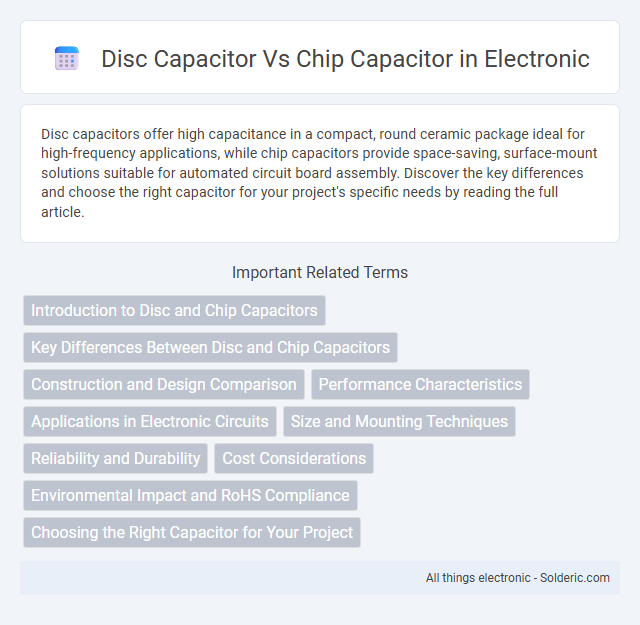Disc capacitors offer high capacitance in a compact, round ceramic package ideal for high-frequency applications, while chip capacitors provide space-saving, surface-mount solutions suitable for automated circuit board assembly. Discover the key differences and choose the right capacitor for your project's specific needs by reading the full article.
Comparison Table
| Feature | Disc Capacitor | Chip Capacitor |
|---|---|---|
| Shape | Disc-shaped, round | Rectangular, flat chip |
| Size | Larger, bulkier | Small, compact |
| Material | Ceramic dielectric | Ceramic or multilayer ceramic |
| Capacity Range | 1 pF to several uF | 0.1 pF to several uF |
| Voltage Rating | Up to 2 kV commonly | Typically up to 500 V |
| Mounting | Leaded, through-hole | Surface Mount Device (SMD) |
| Applications | High voltage, power circuits | Compact circuits, high-frequency, SMD designs |
| Cost | Generally higher per unit | Lower cost, mass production friendly |
| Reliability | Robust, stable under high stress | Good reliability in compact forms |
Introduction to Disc and Chip Capacitors
Disc capacitors, typically made from ceramic materials, offer high capacitance stability and low loss at high frequencies, making them suitable for RF and high-frequency applications. Chip capacitors, also ceramic-based, are designed for surface-mount technology (SMT), enabling compact, automated assembly with reliable performance in modern electronic circuits. The choice between disc and chip capacitors depends on application requirements such as size, mounting method, and frequency response.
Key Differences Between Disc and Chip Capacitors
Disc capacitors use ceramic discs as dielectric materials, offering high capacitance and voltage ratings suitable for high-frequency applications, while chip capacitors are surface-mount devices with smaller sizes, designed for compact circuit boards and automated assembly. You should consider disc capacitors for robust, high-power circuits and chip capacitors when space-saving and mass production are priorities. Key differences lie in their physical construction, mounting techniques, size, capacitance range, and typical application environments.
Construction and Design Comparison
Disc capacitors feature a ceramic or metal oxide disc as the dielectric material, providing a simple, robust structure ideal for high-frequency applications. Chip capacitors consist of stacked layers of metal electrodes and ceramic dielectric, enabling compact size and higher capacitance per volume for surface-mount technology. Your choice depends on space constraints and performance requirements, with disc capacitors offering durability and chip capacitors delivering miniaturization and precision.
Performance Characteristics
Disc capacitors exhibit high insulation resistance and low dielectric losses, making them ideal for high-frequency applications and pulse circuits. Chip capacitors offer superior volumetric efficiency with stable capacitance values and low equivalent series resistance (ESR), enhancing performance in surface-mount technology (SMT) and high-density PCB designs. Both capacitor types demonstrate distinct advantages in tolerance, temperature stability, and frequency response tailored to specific electronic circuit requirements.
Applications in Electronic Circuits
Disc capacitors are widely used in high-frequency applications such as RF circuits, EMI suppression, and timing circuits due to their low inductance and stability. Chip capacitors, especially ceramic types, are favored for surface-mount technology (SMT) in compact devices, including smartphones, computers, and automotive electronics, where space-saving and high capacitance per volume are critical. Both types are essential in filtering, coupling, and decoupling tasks, with chip capacitors excelling in automated manufacturing environments and disc capacitors preferred in through-hole assemblies requiring robust performance.
Size and Mounting Techniques
Disc capacitors are typically larger and designed for through-hole mounting, requiring leads to be inserted into drilled PCB holes, making them suitable for high-voltage or high-frequency applications. Chip capacitors are compact surface-mount devices (SMD) with flat rectangular shapes, ideal for automated assembly on densely packed PCBs where space savings and high component density are crucial. Your choice between these capacitors depends on the available PCB space and the preferred assembly process, with chip capacitors offering smaller footprints and easier integration in modern electronics.
Reliability and Durability
Disc capacitors generally offer higher reliability and durability due to their robust ceramic dielectric and ability to handle high surge currents without significant degradation. Chip capacitors, while compact and ideal for surface-mount technology, may exhibit lower mechanical strength and can be more susceptible to cracking under physical stress or thermal cycling. Your choice should consider the operating environment and stress factors to ensure long-term performance.
Cost Considerations
Disc capacitors generally offer a lower cost per unit compared to chip capacitors, making them advantageous for budget-sensitive applications. Chip capacitors, while more expensive, provide better performance and reliability in high-frequency and space-constrained designs, which can justify their higher price. Volume production and material differences significantly influence the cost gap between disc and chip capacitors.
Environmental Impact and RoHS Compliance
Disc capacitors typically contain fewer toxic materials and often show better compliance with RoHS (Restriction of Hazardous Substances) directives compared to chip capacitors, which may include lead-based solder or other hazardous elements. Your choice between disc and chip capacitors can influence the environmental footprint of your electronic assemblies, as disc capacitors generally offer easier recyclability and reduced hazardous waste generation. Ensuring component selection aligns with RoHS standards not only advances regulatory compliance but also supports sustainable manufacturing and end-of-life disposal practices.
Choosing the Right Capacitor for Your Project
Disc capacitors offer high voltage ratings and stable performance, making them ideal for applications requiring reliable energy storage and filtering. Chip capacitors are compact and suited for high-frequency circuits due to their low inductance and surface-mount design, perfect for space-constrained electronic projects. Your choice depends on voltage, frequency, and size requirements to ensure optimal circuit performance.
disc capacitor vs chip capacitor Infographic

 solderic.com
solderic.com